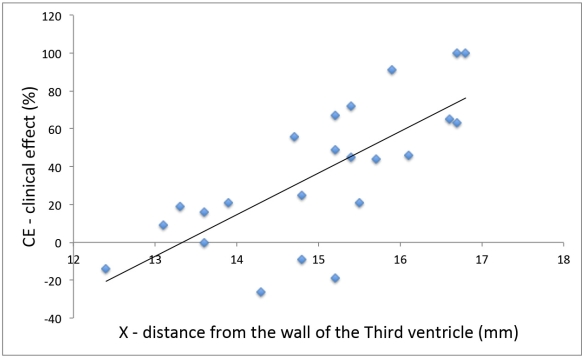Session Information
Date: Thursday, June 23, 2016
Session Title: Dystonia
Session Time: 12:00pm-1:30pm
Location: Exhibit Hall located in Hall B, Level 2
Objective: To detect the relationship between the long-term clinical outcome of deep brain stimulation (DBS) in patients with dystonia and the electrode position in the motor part of the globus pallidus interna (GPi).
Background: GPi DBS is an effective treatment for dystonic syndromes with a relatively high variability of clinical benefit. With the absence of clear inclusion criteria it is difficult to predict the future clinical benefit of this treatment. Therefore we retrospectively searched for an optimal location of the electrode within the GPi as an anatomical marker for best responsiveness to DBS in dystonia.
Methods: We examined 23 patients (mean age 48±(SD)18 years) with dystonia (duration 14±6 years) of various distribution and origin treated by chronic bilateral DBS with electrodes implanted into posteroventrolateral portion of the GPi using stimulation parameters (1.9±0.5V, 1.8±0.7mA, 289±109us, 50-130 Hz). The clinical effect (CE) was expressed as a change in the dystonic score (Burke-Fahn-Marsden Dystonia rating Scale or Toronto Western Spasmodic Torticollis Scale) between the actual GPi DBS ON condition and the preoperative state. T1-weighted 1.5 T MR images (MPRAGE, 0.9×0.9×0.9 mm) were acquired in each patient 3.7±2.2 years after electrode implantation. Coordinates were measured in native space using well-defined susceptibility artifacts induced by contacts of the electrode. While the x-coordinate of each contact was measured from the wall of the third ventricle, the y- and z-coordinates were measured from the midcommisural point. Data was analyzed by correlation of change in normalized CE with position of the distal contact of the electrode in each direction.
Results: The x-coordinate of the more medial contact of the two implanted electrodes positively correlated with CE improvement (r=0.73, P<0.0001). In addition, responders (patients with more than 25% CE) had their contacts located 1.2 mm more laterally than non-responders (P=0.02).
In addition, responders (patients with more than 25% CE) had their contacts located 1.2 mm more laterally than non-responders (P=0.02).
Conclusions: Our neuroanatomical study suggests the presence of a motor gradient along the medio-lateral axis in the GPi which is associated with long-term clinical outcome of DBS in dystonia regardless of etiology. According to our results we postulate that patients with any of the two electrodes placed too medially within GPi will have a poor response to DBS. Supported by the grant IGA MZ CR NT12282-5/2011.
To cite this abstract in AMA style:
R. Jech, A. Fecíková, D. Štastná, T. Serranová, D. Urgošík, F. Ruzicka. The clinical benefit of pallidal stimulation in dystonia is related to the electrode position in the medio-lateral direction [abstract]. Mov Disord. 2016; 31 (suppl 2). https://www.mdsabstracts.org/abstract/the-clinical-benefit-of-pallidal-stimulation-in-dystonia-is-related-to-the-electrode-position-in-the-medio-lateral-direction/. Accessed January 5, 2026.« Back to 2016 International Congress
MDS Abstracts - https://www.mdsabstracts.org/abstract/the-clinical-benefit-of-pallidal-stimulation-in-dystonia-is-related-to-the-electrode-position-in-the-medio-lateral-direction/
